Watching for Soybean Diseases? Remember these Key Signs
December 13, 2018
Frogeye leaf spot, white mold, Sudden Death Syndrome — to achieve maximum yield and grain quality, you must protect your soybeans from these and other key diseases throughout the growing season.
Soybean disease management is achieved through an integrated approach of best management practices, from disease identification to seed treatments and fungicides. This begins with learning the signs of disease in your soybean fields.
Septoria Leaf Spot (Brown Spot)
How to Spot it: Brown spot causes small, angular to somewhat circular brown or red spots on unifoliate and lower trifoliate leaves. Infected unifoliate leaves will yellow and drop prematurely. The disease usually appears on the lower section of the plant, but under favorable warm, wet conditions, the disease may travel up through the plant.
When to Watch: Infection can occur at any stage of soybean development, but it often shows up after flowering.
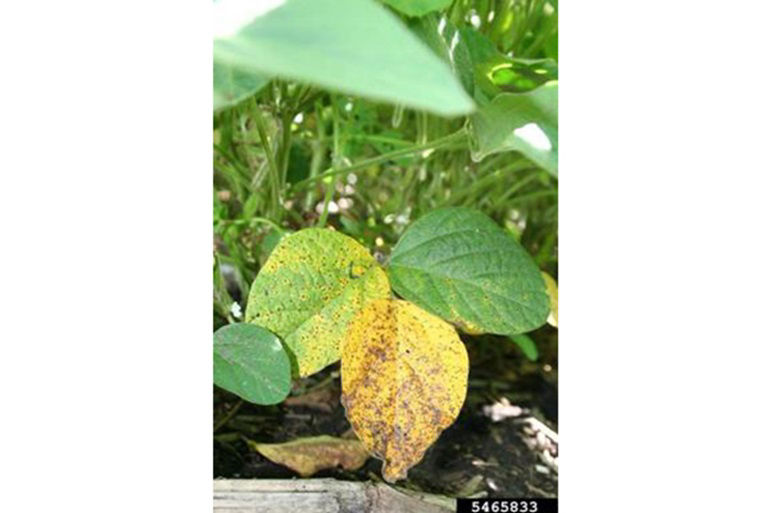
Frogeye Leaf Spot
How to Spot It: Symptoms occur primarily on leaves. Lesions consist of small, circular to irregular dark spots, which develop on the upper leaf surfaces. Eventually the spots enlarge and inhibit photosynthesis. The centers of the lesions become gray to brown and have reddish purple margins. Heavily spotted leaves usually wither and drop off prematurely.
When to Watch: Frogeye leaf spot is most serious in warm regions or during humid, wet weather. Leaves developing during warm, wet conditions are more likely to be infected than leaves expanding during dry periods. Infection can occur at any stage of soybean development, most often during flowering.
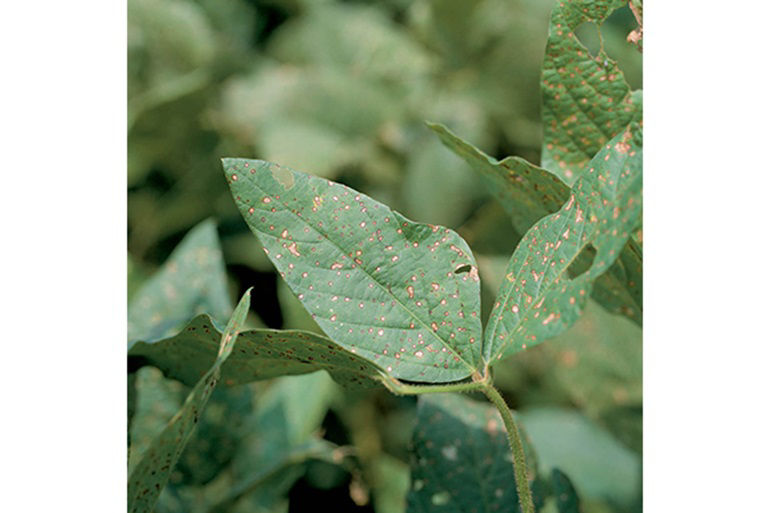
Asian Soybean Rust (Soybean Rust)
How to Spot It: The most common symptom is foliar lesions, which appear as small, yellow specks on the tissue of the upper leaf surface, concentrating near leaf veins. They are typically angular to somewhat circular in shape. These lesions then darken, with colors ranging from reddish-brown or dark brown to tan or gray-green. With heavy infections, lesions may be larger and merge together, killing large areas of leaf tissue. When conditions are favorable for the development of this disease, foliage may yellow and defoliate, resulting in premature death.

Powdery Mildew
How to Spot It: Symptoms on the leaves include green and yellow “islands,” interveinal necrosis, necrotic specks and crinkling of the leaf blade followed by defoliation. Necrosis causes leaves, stems and other plant structures to darken and wilt, weakening the soybean plant and making it more susceptible to other diseases and pests.
When to Watch: Powdery mildew in soybeans is a windblown pathogen, which requires cool air temperatures and low relative humidity.

Pod and Stem Blight
How to Spot It: Key signs of soybean pod and stem blight are many small, black, raised dots arranged in rows on infected stems, pods and fallen petioles late in the season. Upper portions of infected plants may turn yellow and die. Infected seeds are cracked, shriveled and dull and may have a gray mold. Infected seeds can have low viability and decompose at harvest.
When to Watch: This soybean blight disease may be more common when harvesting is delayed during wet weather. Signs of infection can appear in mid-season and on plants nearing maturity.
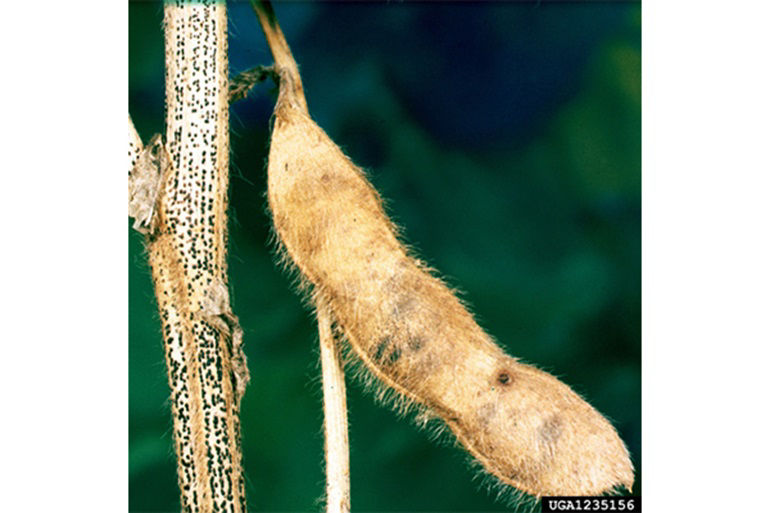
Sclerotinia Stem Rot (White Mold)
How to Spot It: Early symptoms of Sclerotinia stem rot, also called white mold, may be the wilting of leaves in the upper canopy. Leaves may look gray-green, off-color or wilted. Cankers may appear on the stems at the nodes.
When to Watch: White mold is prone to develop in moderate temperatures (less than 82 degrees F) in the canopy and under frequent rainfall, especially as the plants begin to flower and set pods. White mold can cause extensive yield losses in fields that otherwise have high yield potential.

Sudden Death Syndrome (SDS)
How to Spot It: Soybean Sudden Death Syndrome (SDS) causes interveinal chlorotic or necrotic spots, and may eventually cause leaves to curl up or drop prematurely, while the petioles remain firmly attached. Fields with severe foliar symptoms will have a tan to brown cast. Next, flowers abort and pods fail to fill seed. One characteristic of SDS is that the interior, or pith, of the stem remains white. SDS can occur as a disease complex with soybean cyst nematode (SCN), often resulting in early and more severe symptoms.
When to Watch: The above ground symptoms of SDS generally appear midsummer, after blooming, but the infection of the pathogen (Fusarium virguliforme) actually occurs at the seedling stage. The disease is a serious threat from the time the seed starts to germinate and throughout the growing season. Because SDS attacks at the root first, by the time above ground symptoms are visible, it's too late to protect against the disease.
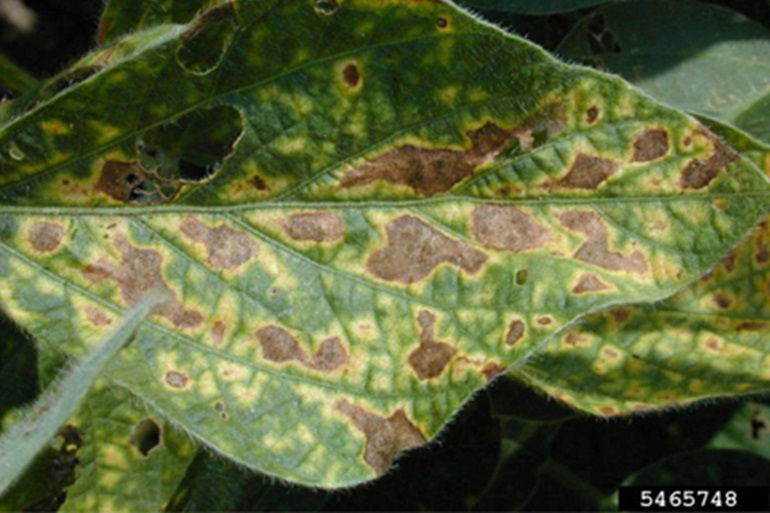
Rhizoctonia Root Rot
How to Spot It: While disease caused by the fungus Rhizoctonia can cause seedling blight, it also causes root rot in more mature soybean plants. At this later growth stage, lower leaves may begin to turn yellow. Plants may appear stunted and less vigorous. Infected plants, when dug up from the soil, may reveal poorly developed root systems and lateral roots that are discolored or rotted. The stem may have a brick-red discoloration at the soil line that extends in either direction. Severely infected soybean plants that are stressed by hot, dry conditions may die. If cool, wet conditions occur after a Rhizoctonia infection, a flush of secondary roots above the stem may be visible.
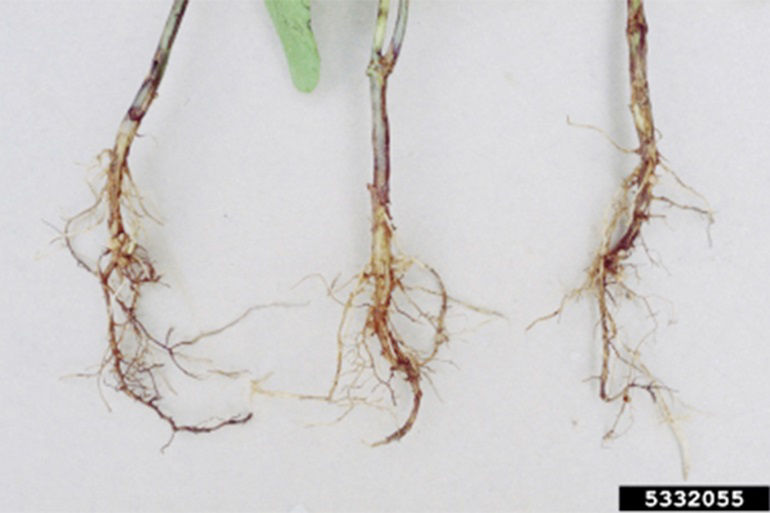
Charcoal Rot
How to Spot It: In advanced stages, leaves turn yellow, wilt and wither, but remain attached. After the flowering stage, the taproot and lower stem appear silver or light gray. In later stages of the disease, black specks appear underneath the “bark” that is peeled away from the roots and stem base – hence the name charcoal rot. Seedling infestations of charcoal rot may mimic those of Rhizoctonia, producing reddish lesions on the stem of the seedling. Where charcoal rot is present, these lesions can be scraped off with light pressure.
When to Watch: Charcoal rot typically develops in hot, dry weather in combination with nutrient-deficient soils or unfavorable growing conditions.

Phytophthora Root Rot
How to Spot It: Plants infected early in the season with the fungus Phytophthora may appear as leaf blight, not showing symptoms until later in the season. As plants enter the flowering stage and begin to set pods, symptoms of late-season stem and root rot may develop. Infected older plants show reduced vigor or gradually die over the season. The stems show brown discoloration, which extends upward from below the soil line.

Anthracnose
How to Spot It: Typically, this fungal disease develops as a stem and pod disease on soybean plants during later reproductive growth. Anthracnose may also cause tip blight in early pod-filling stages. Irregularly shaped brown lesions may develop on pods, petioles and stems. The fungus also produces small, black, fruiting bodies, or acervuli, that erupt in infected tissue.
When to Watch: Anthracnose typically develops in warm, wet weather. If wet weather continues through harvest, the symptoms on stems will be more severe.
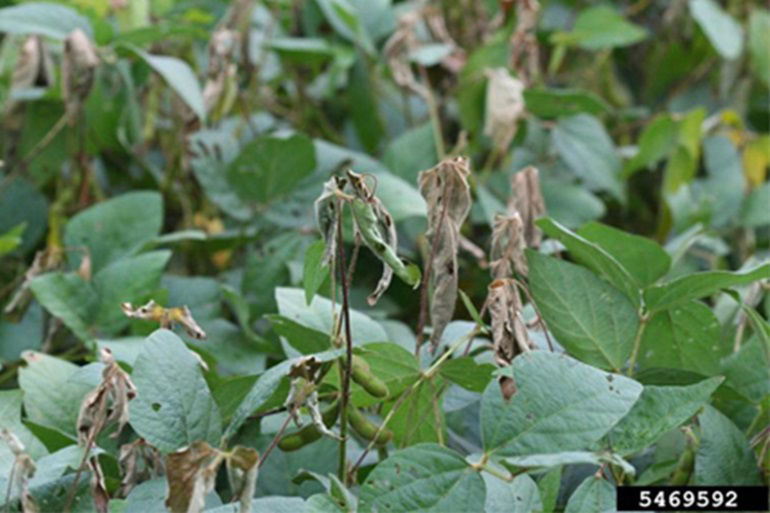
Brown Stem Rot
How to Spot It: Foliage symptoms usually develop as soybean plants are beginning to set pods. Leaf symptoms, which may be similar to those of Sudden Death Syndrome, appear as light green to yellow blotches in the interveinal leaf tissue. The vascular tissues and pith of the soybean stem is also affected with a brown discoloration; this can be seen when the stems are split open. Later in the season, this brown discoloration may appear almost continuous within the stem.
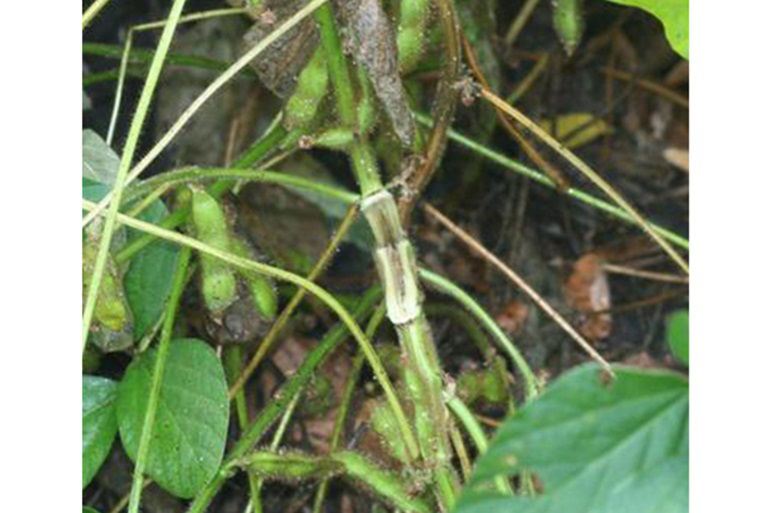
Bayer Solutions for Soybean Diseases
Best management practices help minimize the potential for fungicide resistance and include cultural practices and applying fungicides with multiple modes of action.
Choose Seed Treatments for a Strong Start
A fungicide seed treatment can provide a healthy start for seedlings. Multiple fungal pests can impact soybean seeds and seedlings immediately after planting, and EverGol® Energy SB can protect against pests causing the most damage such as Rhizoctonia solani, Fusarium spp and Pythium spp.
Use Fungicides for Continued Protection
Timely fungicide applications, including foliar fungicides, can help protect soybean plants from fungal diseases through the season.
Bayer offers Stratego® YLD, a fungicide featuring triazole technology combined with strobilurin chemistry for soybeans. Offering two modes of action, it provides both preventive and curative benefits and systemic movement to provide broad-spectrum, long-lasting disease control and higher yield potential. Trials show that when applied at early flowering, around growth stage R3, Stratego YLD can deliver an average yield increase of 3 to 4 bushels per acre over untreated soybean fields. For cost efficiency, fungicides can be tankmixed with insecticides and applied in the same trip across the field.
Before applying any fungicide, please read the entire label for the best possible results and to confirm that the product is effective on the disease you need to control. Not every product is suitable for every situation, and correct application technique will ensure the best results.
To learn more about products Bayer offers to help control diseases in soybeans, contact your local Bayer sales representative.
Before applying any fungicide, please read the entire label for the best possible results and to confirm that the product is effective on the diseases you wish to control. Not all products are registered in all states.